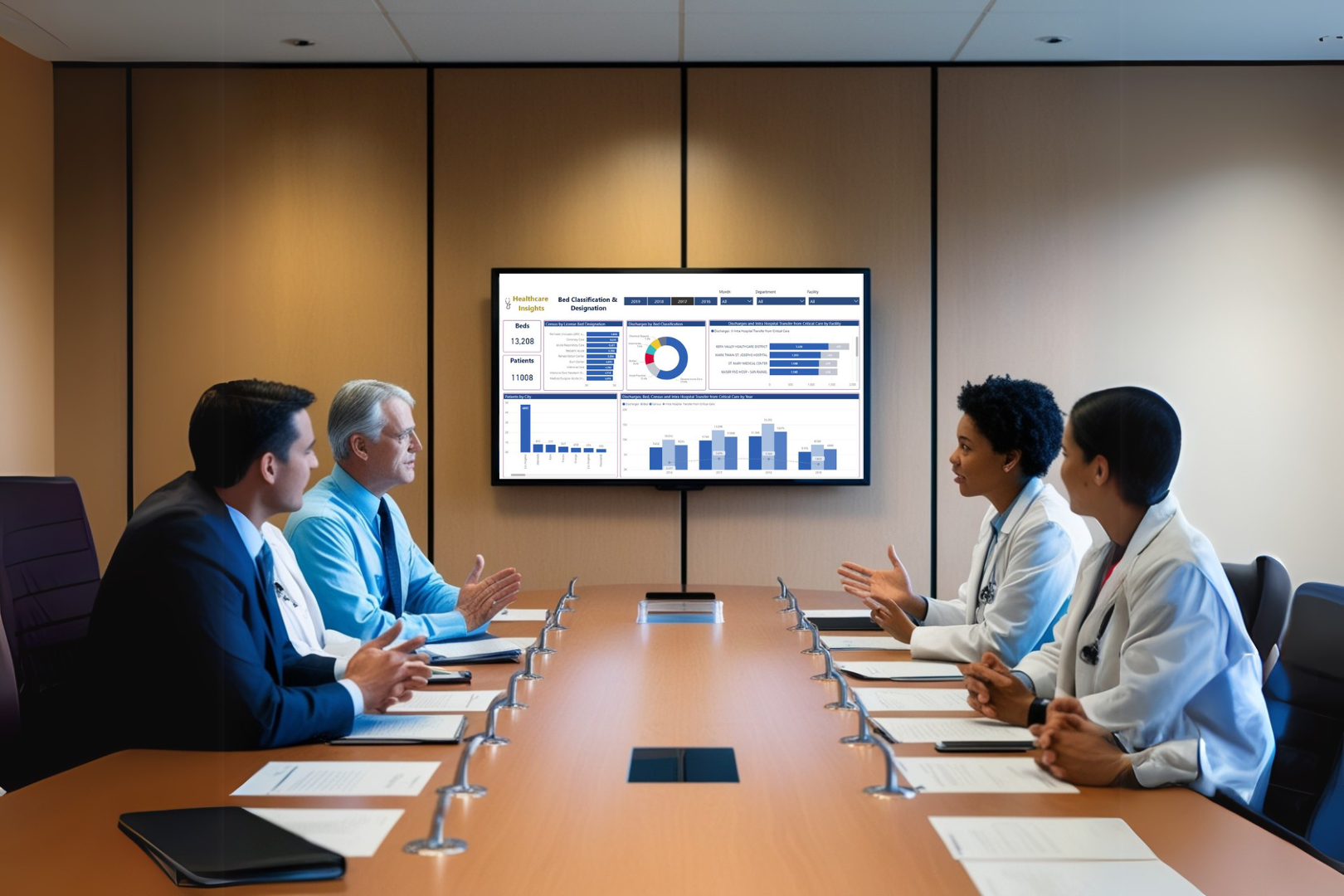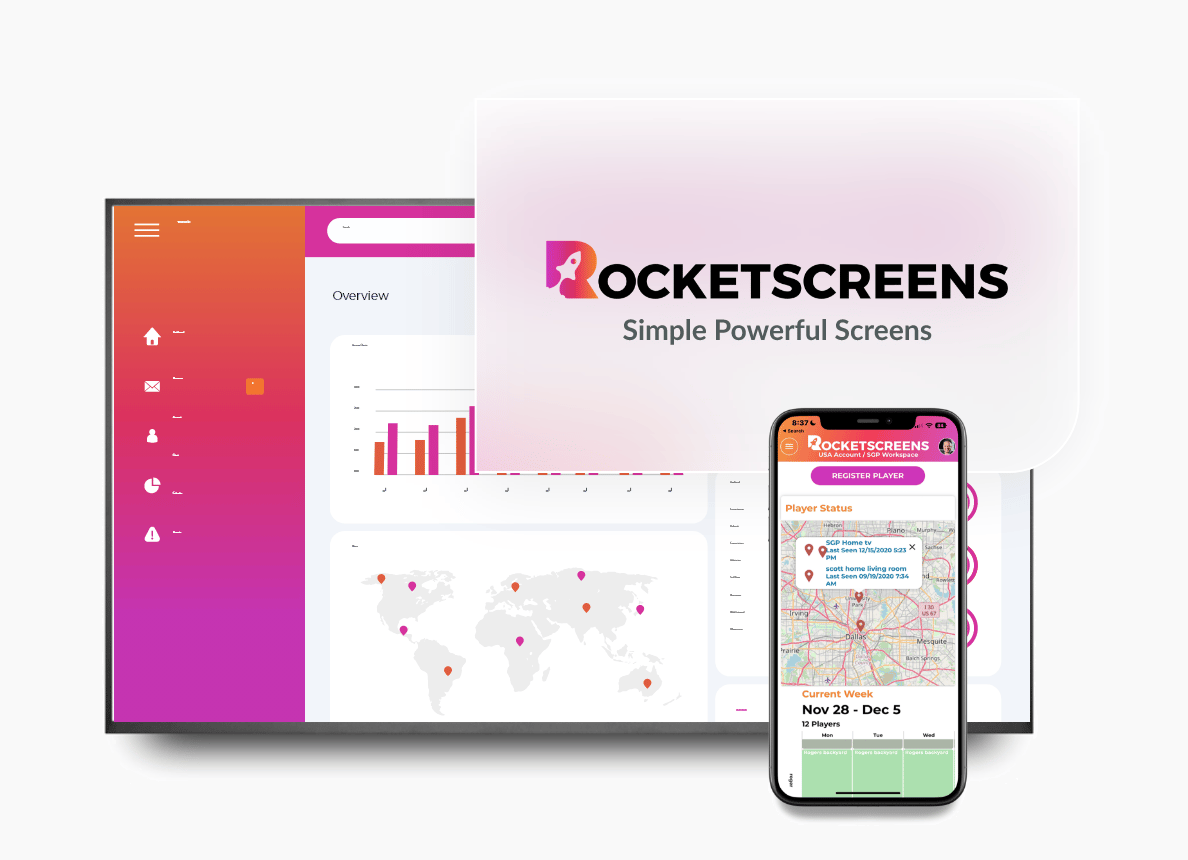
Healthcare facilities are rapidly evolving to meet the demands of modern patient care and operational excellence. Digital signage, particularly Healthcare Facility TV Dashboards, has emerged as a pivotal tool in displaying real-time metrics, ensuring regulatory compliance, and promoting best practices. In today’s fast-paced environment, effective communication and timely data delivery are vital. By leveraging advanced digital signage solutions such as RocketScreens, hospitals, clinics, and other healthcare institutions can optimize their operations and improve patient outcomes.
In this detailed guide, we will explore the critical role of Healthcare Facility TV Dashboards, the key healthcare metrics they display, the compliance requirements they must meet, and the best practices for their implementation. We will also discuss how RocketScreens integrates seamlessly with over 100 applications to offer a secure, scalable, and user-friendly platform for healthcare displays and medical dashboards.
1. Overview of Healthcare Facility TV Dashboards
1.1 What Are Healthcare Facility TV Dashboards?
Healthcare Facility TV Dashboards are digital displays strategically placed in hospitals, clinics, and other medical facilities. They serve multiple functions—from showcasing real-time patient metrics and operational data to delivering critical alerts and educational content. These dashboards are designed to provide a snapshot of key performance indicators (KPIs), enabling healthcare professionals to make informed decisions swiftly.
1.2 The Importance of Real-Time Data
In healthcare settings, timely information can be the difference between life and death. Real-time data displayed on these dashboards includes patient wait times, bed occupancy rates, emergency response times, and other vital statistics. With immediate access to this data, medical teams can quickly identify bottlenecks, adjust workflows, and allocate resources more effectively.
1.3 Enhancing Communication and Engagement
Healthcare Facility TV Dashboards not only serve as information hubs but also enhance communication across departments. By displaying standardized and dynamic content, these dashboards foster transparency and ensure that all stakeholders—from doctors and nurses to administrative staff—are aligned. This integrated communication channel is vital for maintaining high levels of patient care and staff engagement.
2. Key Healthcare Metrics Displayed on TV Dashboards
2.1 Critical Patient Metrics
One of the primary functions of Healthcare Facility TV Dashboards is to monitor and display critical patient metrics. These metrics help healthcare providers track the performance of their facilities and ensure that patients receive timely care.
- Patient Wait Times: Monitoring wait times in emergency departments, outpatient clinics, and other areas ensures that patient flow is optimized.
- Bed Occupancy Rates: Real-time updates on bed availability help in managing patient admissions and discharges.
- Patient Satisfaction Scores: Aggregated feedback from patient surveys can be displayed to highlight areas of excellence and identify opportunities for improvement.
- Infection Rates: Tracking hospital-acquired infections in real-time allows for rapid intervention and improves overall patient safety.
2.2 Operational Efficiency Metrics
Operational metrics provide insight into the day-to-day functioning of healthcare facilities. These metrics include:
- Staff Utilization: Insights into staffing levels and workload distribution ensure that the right resources are available at the right time.
- Resource Allocation: Monitoring the usage of critical resources such as ventilators, medical supplies, and diagnostic equipment.
- Financial Performance: Real-time financial data, including revenue, expenses, and cost per patient, helps in budgeting and financial planning.
- Appointment Scheduling: Data on scheduled versus walk-in patients assists in optimizing appointment slots and reducing patient backlog.
2.3 Public Health and Community Metrics
Beyond internal operations, Healthcare Facility TV Dashboards can also display community-related health data, which can be vital during public health emergencies or seasonal outbreaks.
- Immunization Rates: Tracking vaccination data to monitor community immunity levels.
- Local Disease Outbreaks: Real-time alerts on outbreaks or health advisories.
- Preventative Health Campaigns: Information on upcoming community health events and awareness programs.
These healthcare metrics not only improve internal processes but also enhance patient trust and satisfaction by demonstrating transparency and a commitment to quality care.
3. Compliance and Regulatory Requirements in Healthcare Displays
3.1 Navigating the Complex Regulatory Landscape
Healthcare facilities operate under strict regulatory frameworks to ensure patient safety and privacy. Digital signage used within these environments must adhere to these regulations, which include standards such as HIPAA (Health Insurance Portability and Accountability Act) in the United States and GDPR (General Data Protection Regulation) in Europe.
- Data Privacy: Any display of patient information must be secure and restricted to authorized personnel. Encryption and secure network connections are critical in preventing data breaches.
- Content Approval Processes: All information displayed on Healthcare Facility TV Dashboards should go through rigorous verification and approval processes to ensure accuracy and compliance.
- Audit Trails: Maintaining detailed logs of displayed content and user access is essential for compliance audits and can help identify any breaches or discrepancies.
3.2 Best Practices for Ensuring Compliance
Ensuring that your digital signage meets all compliance requirements involves several best practices:
- Encryption and Secure Connections: Utilize platforms that offer end-to-end encryption and secure connection protocols. RocketScreens, for example, connects securely to over 100 applications, ensuring that all data displayed is protected.
- User Access Controls: Limit access to sensitive data by implementing role-based permissions. Only authorized personnel should be able to modify or access critical information.
- Regular Compliance Audits: Conduct frequent internal and external audits to ensure that your digital signage solutions adhere to the latest regulatory standards.
- Staff Training: Ensure that all staff members are well-versed in compliance protocols and understand the importance of protecting patient data.
- Content Management Systems (CMS): Use CMS tools that provide built-in compliance checks, ensuring that all content meets regulatory requirements before it is published.
3.3 Integrating Compliance into Digital Signage
Integrating compliance into your digital signage strategy is not just about technology—it’s about building a culture of accountability and precision. By following stringent compliance protocols, healthcare facilities can minimize risks and focus on delivering superior patient care.
4. Best Practices for Implementing Healthcare Facility TV Dashboards
4.1 Designing Effective Medical Dashboards
The design of medical dashboards is crucial in ensuring that the displayed information is clear, concise, and actionable. Consider the following best practices:
- User-Centric Design: Design dashboards with the end-user in mind. Ensure that the most critical information is easily accessible and legible, even from a distance.
- Prioritize Readability: Use high-contrast color schemes, large fonts, and intuitive icons to make the dashboards readable in various lighting conditions.
- Data Hierarchy: Organize data in a logical order. For example, critical alerts should be placed at the top of the display, while less urgent information can be positioned lower.
- Customization: Allow for customization so that different departments can tailor the dashboard to display the metrics most relevant to their operations.
- Responsive Layouts: Ensure that your dashboards are responsive and can adapt to different screen sizes and orientations. This is especially important in facilities with a mix of digital signage devices.
4.2 Installation and Placement Strategies
Effective placement of digital signage can significantly enhance communication and workflow. Here are some placement strategies:
- High-Traffic Areas: Place dashboards in areas where staff and patients spend the most time, such as waiting rooms, lobbies, and corridors.
- Critical Decision Points: Install displays near nurse stations, emergency departments, and administrative offices where real-time decision-making is crucial.
- Patient Rooms: Consider smaller displays in patient rooms to provide personalized information, such as daily schedules, medication times, or health tips.
- Integration with Wayfinding: Use digital signage to also assist with wayfinding within the facility. Clear directional displays can reduce patient anxiety and improve overall experience.
4.3 Content Management and Scheduling
A dynamic digital signage solution requires robust content management. Effective content management ensures that the displayed data is both accurate and engaging.
- Automated Updates: Use systems that automatically pull data from integrated applications. This minimizes manual intervention and reduces the risk of human error.
- Scheduling Content: Develop a content schedule that includes routine updates, emergency alerts, and educational material. This balance ensures that the information remains fresh and relevant.
- Feedback Loops: Implement mechanisms to gather feedback from staff and patients on the effectiveness of the displayed information. Use this data to refine content and improve overall communication.
- Integration with Hospital Information Systems: Seamlessly integrate dashboards with electronic health records (EHR) and other hospital management systems. This integration ensures that the displayed information is always up-to-date and accurate.
4.4 Training and Support
Successful implementation of Healthcare Facility TV Dashboards depends on the users’ ability to operate and maintain them effectively. Best practices in training and support include:
- Comprehensive Training Programs: Offer detailed training sessions for staff members on how to use and manage the digital signage platform.
- Dedicated Support Channels: Provide round-the-clock technical support to resolve any issues quickly.
- Regular Updates: Keep staff informed about new features and upgrades. Regularly scheduled training refreshers help maintain a high level of proficiency.
- User Manuals and Tutorials: Create easy-to-follow guides and video tutorials that can help new users get up to speed quickly.
5. The Role of Digital Signage Platforms like RocketScreens
5.1 Why Choose RocketScreens for Healthcare Displays?
RocketScreens offers a robust, secure, and user-friendly digital signage platform that is perfectly suited for healthcare environments. Here’s why healthcare facilities are increasingly turning to RocketScreens for their medical dashboards:
- Seamless Integration: With the ability to connect securely to over 100 applications, RocketScreens ensures that all critical healthcare metrics and operational data are consolidated into one easy-to-use interface.
- Enhanced Security: Data privacy is paramount in healthcare. RocketScreens employs advanced encryption and secure protocols to safeguard sensitive patient information while ensuring compliance with regulations such as HIPAA and GDPR.
- User-Centric Design: The platform is designed with ease of use in mind, enabling healthcare professionals to quickly customize and deploy dashboards tailored to their specific needs.
- Real-Time Data Updates: RocketScreens pulls data in real time, providing healthcare professionals with the most current information to facilitate quick decision-making.
- Scalability: Whether it’s a small clinic or a large hospital network, RocketScreens scales effortlessly to meet the needs of any healthcare facility.
5.2 Integrating RocketScreens into Your Facility
Implementing RocketScreens is straightforward, thanks to its intuitive interface and comprehensive support. Here’s how healthcare facilities can integrate the platform into their existing systems:
- Step-by-Step Onboarding: RocketScreens provides a guided onboarding process that helps IT teams and administrators integrate the platform with existing hospital information systems and databases.
- Ongoing Support and Training: Benefit from continuous training sessions, detailed documentation, and a dedicated support team to ensure smooth operation and timely updates.
- Enhanced Analytics: Gain valuable insights through built-in analytics tools that track performance metrics, usage patterns, and patient outcomes.
6. Future Trends in Healthcare Displays and Medical Dashboards
6.1 The Rise of Intelligent Digital Signage
The future of Healthcare Facility TV Dashboards lies in the integration of advanced technologies that can enhance decision-making and operational efficiency. Emerging trends include:
- Artificial Intelligence (AI): AI-powered analytics will soon enable predictive modeling, helping healthcare facilities anticipate patient influxes, optimize staffing, and improve overall service quality.
- Internet of Things (IoT) Integration: IoT devices can provide a constant stream of data, which when integrated with digital signage, can offer even more precise and timely insights.
- Personalized Content: Future dashboards may offer personalized content based on user roles or patient-specific data, ensuring that each user sees information most relevant to their responsibilities.
- Enhanced Interactivity: Touchscreen interfaces and mobile integrations may allow healthcare professionals to interact with dashboards in real time, drilling down into data points for deeper insights.
6.2 Preparing for a Digital Future
As healthcare continues to evolve, the demand for real-time data and dynamic communication channels will only increase. Facilities that invest in advanced digital signage solutions like RocketScreens will be well-positioned to adapt to these changes. Key preparations for the future include:
- Continuous Upgrades: Keep digital signage software and hardware updated to support the latest features and security protocols.
- Investment in Training: Ensure that all staff are comfortable with new technologies by investing in continuous training and education.
- Collaborative Innovation: Work closely with technology partners to co-develop new features that cater specifically to healthcare needs.
- Data-Driven Decision Making: Leverage the analytics capabilities of digital signage platforms to make informed decisions that drive efficiency and improve patient outcomes.
7. Practical Implementation Strategies for Healthcare Facility TV Dashboards
7.1 Planning Your Digital Signage Rollout
A successful rollout of Healthcare Facility TV Dashboards begins with meticulous planning. The following steps can help ensure a smooth implementation:
- Assess Your Needs: Identify the key metrics and operational data that are critical for your facility. Engage with various stakeholders—from clinical staff to IT and administrative teams—to understand their requirements.
- Define Objectives: Establish clear goals for what you want to achieve with your digital signage solution, such as reducing patient wait times, optimizing resource allocation, advertising services, or enhancing communication.
- Budget and Resources: Allocate the necessary budget and resources for hardware, software, installation, and training.
- Pilot Testing: Run a pilot program in select areas of your facility to test the effectiveness of your dashboards. Use feedback from this phase to refine your approach before a full-scale rollout.
7.2 Managing Change and Overcoming Challenges
Transitioning to a digital signage solution can come with challenges. Here are some strategies to manage change effectively:
- Stakeholder Engagement: Involve all relevant stakeholders early in the process. Their buy-in is crucial for a smooth transition.
- Clear Communication: Communicate the benefits and functionalities of the new system clearly to all users.
- Technical Support: Ensure that robust technical support is available during and after the rollout to address any issues quickly.
- Iterative Improvements: Use feedback from staff and patients to make iterative improvements to the dashboard design and content strategy.
7.3 Maximizing the Impact of Your Medical Dashboards
To fully leverage the potential of Healthcare Facility TV Dashboards, consider these tips:
- Regular Content Updates: Keep the information dynamic and up-to-date to maintain user engagement.
- Data Visualization: Use charts, graphs, and infographics to present data in a visually appealing and easily digestible format.
- Interactive Features: Incorporate interactive elements where possible to allow users to dive deeper into data when necessary.
- Cross-Department Collaboration: Encourage departments to share their insights and best practices for using digital signage effectively.
8. Conclusion: Elevating Healthcare Communication with Digital Signage
Healthcare Facility TV Dashboards are no longer a luxury—they are a necessity in today’s fast-paced medical environment. By displaying real-time healthcare metrics, ensuring strict compliance, and following best practices, facilities can significantly improve operational efficiency and patient care. The integration of digital signage with platforms like RocketScreens not only simplifies data management but also enhances communication across the board.
Whether you’re looking to reduce patient wait times, improve staff utilization, or simply create a more engaging environment, adopting modern medical dashboards is the way forward. By following the guidelines outlined in this article, healthcare facilities can harness the power of digital signage to transform the way they operate.
Investing in a digital signage solution like RocketScreens is a strategic move that positions your facility for the future. With its secure connections to over 100 applications, customizable templates, and user-friendly interface, RocketScreens is designed to meet the unique demands of the healthcare industry. Embrace this innovative technology to not only keep up with the rapidly evolving digital landscape but to also set new standards in patient care and operational excellence.
Key Takeaways
- Real-Time Metrics: Healthcare Facility TV Dashboards provide instant access to crucial healthcare metrics, helping facilities make data-driven decisions.
- Regulatory Compliance: Adhering to regulatory requirements such as HIPAA and GDPR is critical. Secure digital signage platforms ensure compliance while safeguarding sensitive data.
- Best Practices: From user-centric design to strategic placement and robust content management, following best practices ensures that your medical dashboards deliver maximum impact.
- Future-Ready: Embracing emerging technologies like AI and IoT will further enhance the capabilities of digital signage in healthcare, paving the way for smarter, more responsive systems.
- RocketScreens Advantage: With seamless integration, top-notch security, and customizable features, RocketScreens offers a digital signage solution that is tailor-made for healthcare facilities.
By investing in Healthcare Facility TV Dashboards that leverage the latest technology and adhere to best practices, healthcare institutions can create environments that are not only efficient but also highly responsive to the needs of patients and staff alike. Embrace the power of digital signage to drive operational excellence, improve patient outcomes, and set a new standard in healthcare communication.
In a rapidly evolving digital landscape, staying ahead means adopting tools that not only meet today’s needs but also anticipate tomorrow’s challenges. With RocketScreens, your facility gains a partner committed to delivering innovative, secure, and effective digital signage solutions that transform the way you communicate critical information. Explore how RocketScreens can elevate your healthcare displays and medical dashboards to new heights—ensuring that every piece of data is a step toward better care, increased efficiency, and a brighter future for your healthcare facility.





